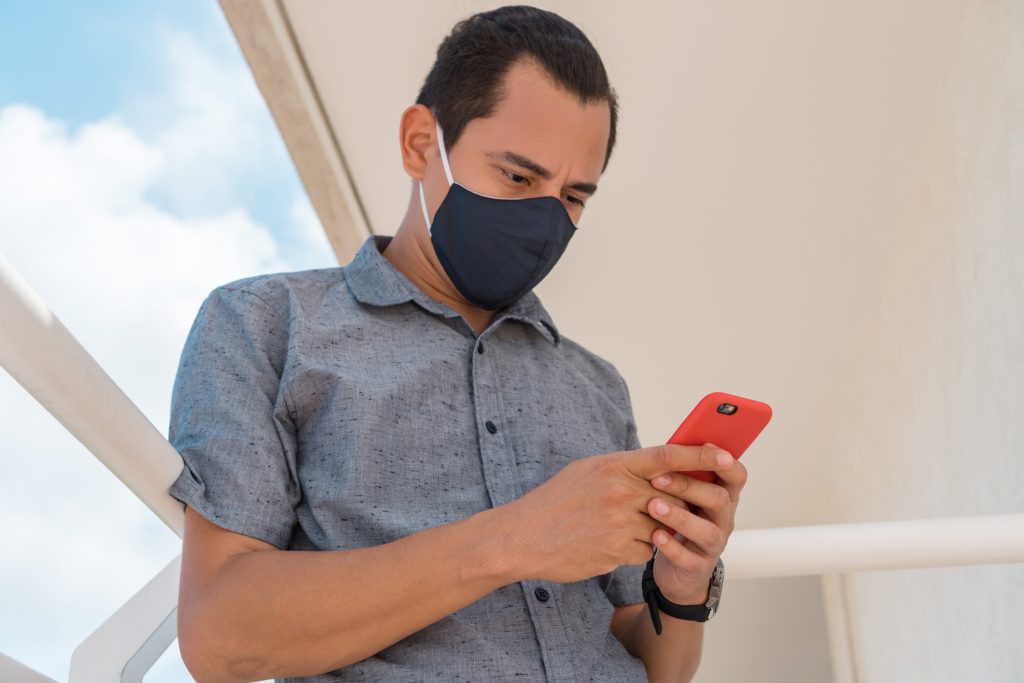
The COVID-19 pandemic has changed and continues to change every aspect of our lives. A fundamental shift has occurred in how we live and think. All this began in 2020 when the world suddenly locked down to limit the spread of COVID-19.
The United States implemented COVID-19 restrictions in late March of 2020. Overnight, people had no access to in-person services. So, they turned to their mobile devices. This produced an attitudinal shift from resentful acceptance to grateful acceptance of mobile apps.
Mobile First: Pandemic Mobile App Development
It was only a matter of time, even without extraordinary circumstances, before businesses would be forced to offer their customers mobile access to their products and services, but COVID-19 has accelerated that demand for almost all types of businesses.
There are just a handful of types of businesses or services that cannot be provided any other way than in person. Hotels, resorts, and cruise lines are types of businesses that depend on in-person customers. Airlines are another. Some medical services, such as surgery and dental work, can’t be done any other way but in person.
However, most businesses can have mobile apps that provide a different avenue for customers to buy their goods or services. Many businesses resisted this trend, because their in-store, brick-and-mortar traffic was so good before the pandemic.
Resistance came from their steep financial investment in brick and mortar infrastructure and a stubborn adherence to a mid-20th-century business model that technology was making obsolete.
Restaurants and grocery stores are prime examples of this. Restaurants had to quickly move from an in-dining service model to a curbside take-out and delivery model, underpinned by a mobile app that made ordering easy for customers.
Pizza chains had this in place already. But now sit-down and fast-food restaurants had to catch up or close. Franchise and fast-food restaurants realized that offering curbside and delivery service and having an easy-to-use mobile app was their key to survival, so many, but not all, adapted quickly.
Likewise, grocery stores realized that a new business model of curbside and delivery service, where customers placed orders through a mobile app, was the only way to be viable during the pandemic.
Some grocery store chains had mobile apps to order groceries that customers could pick up curbside. But the demand for grocery deliveries far outpaced curbside pickups.
Amazon led the way in grocery deliveries through its partnership with Whole Foods. Customers used the delivery service infrequently, preferring to go to a grocery store in person. But, once COVID-19 restrictions were imposed, the demand for grocery delivery skyrocketed, with higher customer demand than open slot availability.
Even though Amazon has been cutting-edge with their mobile apps, it didn’t occur to them to offer to contact customers when an available slot was open, instead of just saying there were no open slots. Strange for Amazon to be behind on this one. How many orders did they lose because customers went somewhere else?
COVID-19 and Mobile App Development
COVID-19 mobile app development extended far beyond restaurants and grocery stores. A sharp rise in mobile app development was pushed by limited access to purchasing any goods and services except through an online method.
Healthcare delivery is a prime example. Before the pandemic began, some medical providers had dabbled in offering telehealth services, but there was little widespread interest or commitment to it as a primary offering to patients.
COVID-19 changed the playing field. The healthcare industry, which relied on in-person visits for payments from private insurance providers, state Medicaid providers, and federal Medicare providers, stood to lose billions of dollars if they could not see patients.
Most healthcare systems had mobile app developers quickly create telehealth systems that ensured continuity of service (and payments). The range of telehealth services spanned from primary care providers to mental health service providers. In-person care was limited to hospital emergency departments and hospital admissions, with stringent restrictions on visitors and visiting hours.
Education is another sector where mobile app development has boomed during COVID-19. Some colleges and universities have had distance and e-learning programs in place for a while, but the pandemic has forced all higher education institutions to offer virtual programs, which meant more mobile app development.
The pandemic itself fed mobile app development. As conditions and restrictions changed frequently, local, state, and national governments needed mobile apps that could immediately alert citizens of changes affecting them. In addition, attempts to contain the spread of COVID-19 led to the development of mobile apps that would alert people if they had possibly been exposed to the virus.
COVID-19 Forced Mobile App Development to Get Better–Fast
Mobile app developers have been very busy developing new mobile apps for all sorts of businesses during the pandemic. Virtual meetings, whether for work, health visits, legal visits, court trials, education, dates, family visits, or game nights became the cornerstone that kept people connected to each other.
There were several players already in the virtual meeting space when the COVID-19 pandemic began. Among these were Skype, Go To Meeting, Microsoft Teams, and a little, almost-unknown app called Zoom.
Most of the better known virtual meeting apps were clunky, hard to use, or didn’t have a free offering for group meetings. Zoom focused on these weaknesses, and quickly became the frontrunner for virtual connections.
Zoom offered free meetings to groups for 40 minutes (groups quickly learned that all you had to do was start another 40 minute session to keep longer meetings going) and very affordable pricing for users who needed advanced virtual meeting capabilities. Their app was easy for novice and aficionado alike.
Zoom forced Microsoft to dramatically improve MS Teams, the virtual meeting app used by many businesses. Microsoft’s story is a story that ripples through mobile app development during the pandemic. Newer competitors unburdened by “we’ve always done it this way” can quickly gain market share from more established competitors.
COVID-19 Mobile App Development Lessons and Trends
Businesses have learned that customers want more mobile and they want it to be easy to use. Customers have learned to embrace the digital experience.
Some businesses that avoided going digital or mobile because they wanted to keep their storefronts front and center are playing catch-up. They realize now that it’s imperative that their businesses operate digitally. This was inevitable, but COVID-19 accelerated the process.
Companies developing mobile apps are also having to adapt. One trend is that mobile app developers want to work remotely. Now that developers have realized they don’t have to endure long commutes to offices to do great work, they don’t want to go back to the way it was before COVID-19.
Companies that do mobile app development are adjusting to empty offices and accommodating their developers who want to continue owrking remotely. They are also finding new ways to conduct customer research, as they perfect their User Interface (UI) and the User Experience (UX) with user testing. They are learning how to use digital tools to capture critical visceral feedback that they get when users are using an app.
These challenges are being negotiated and will be overcome, even though the way through them is a bit murky right now.
How Software Design Solutions Can Help Your Business with Mobile Application Development
When you hire us to help develop mobile applications for your business, we start by getting the right information:
- Understanding your business goals and how you want to meet them
- Understanding your customers and their needs
- Analyzing your products and services to determine if they can be delivered in a different, mobile-enabled way
Transforming your business to a mobile model is not nearly as easy as you might hope. It will take longer and may cost more than you might assume. However, this is as important, if not more important, than building another storefront or plant.
Giving your customers a mobile way of doing business with you is the most strategic investment you can make in your business. Easy mobile use and interaction defines your brand. Because of COVID-19, this may become the primary way your customers interact with you.
If you’re ready to give your customers the mobile experience they want, contact us to find out how we can help you do it well and do it right the first time.


